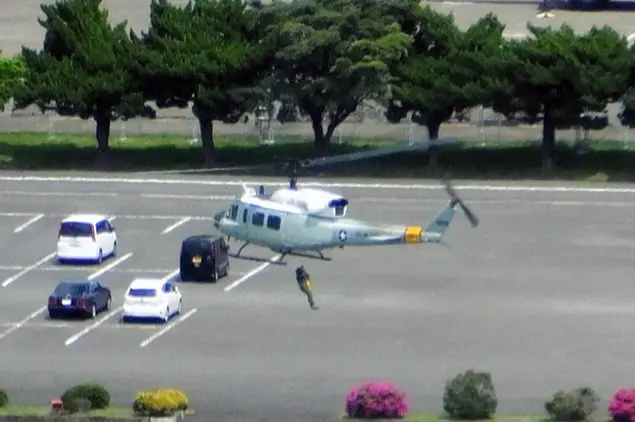A gray helicopter hovering overhead shattered the peaceful outings of families on the waterfront of this port city southwest of Tokyo.
“(The helicopter) suddenly appeared, and I was frightened because I had no idea what was going on,” said a 47-year-old woman who was at the Minato Mirai area with her family on the April 29 national holiday.
She was not alone in her confusion.
Apparently, no one at any Japanese government office, from the central government to the municipal level, was aware that the U.S. military was conducting a training exercise around the Yokohama North Dock on that day.
The incident not only is a possible violation of the Status of Forces Agreement (SOFA) between Japan and the United States, but it also highlights a problem concerning the U.S. military’s notifications to Japanese authorities about exercises beforehand.
The helicopter was transporting U.S. personnel involved in a drill at the Yokohama North Dock, a port facility measuring about 630,000 square meters that has been provided to the U.S. military. It is mainly managed by the U.S. Army and is used for transporting and storing supplies and cargo.
The Yokohama North Dock is also near the Minato Mirai area, a site frequented by tourists.
“I would find it difficult to believe that the military was training in an amusement area with many visitors,” the 47-year-old woman said.
The North Dock, nearby waters and the airspace over the area have not been designated as a facility where the U.S. military can conduct training exercises, meaning that the drill could violate SOFA.
Tokio Kaneko, a co-leader of Rimpeace, an organization set up to monitor U.S. military bases in Japan, expressed outrage that a “dangerous” training exercise had started without prior notice in an area where it should not have been held.
“The central government cannot plead ignorance but should grasp the situation to inform residents as well as negotiate with the U.S. side and ask that the training be stopped,” Kaneko said. “There is a need for local governments to constantly call on the central government to deal with such matters.”
In response to questions from The Asahi Shimbun, the headquarters of U.S. Forces Japan confirmed that a UH-1 helicopter from the Yokota Air Base conducted the training on April 29 in the North Dock area. The headquarters also said a similar training exercise was held during the day and at night on April 25.
The training involved the use of hoists attached to the helicopter, and personnel in the nighttime training used night-vision goggles.
Officials of the Defense Ministry, the Yokohama city government and the Kanagawa prefectural government were not aware of the training until they were contacted by The Asahi Shimbun.
City and prefectural government officials said the North Dock was a port facility and not a training one. Japanese officials said they had never heard of training being held at the North Dock and have begun confirming with their U.S. counterparts about what happened.
“It is a location to unload and store supplies,” an official with the South Kanto Defense Bureau said.
An official with the Yokohama city government section dealing with U.S. bases said, “If there are concerns about the effects on neighboring areas and residents, we will consider what measures to take.”
The U.S. military in the past has voluntarily informed the central government in advance about major training exercises as well as deployment and changes in equipment at its bases. The information is then passed on to local governments.
But the U.S. military is under no obligation to notify the Japanese side. Some local governments, including those that host Yokota Air Base and Naval Air Facility Atsugi, have asked for a more thorough release of such information.
(THE ASAHI SHIMBUN)
 简体中文
简体中文

